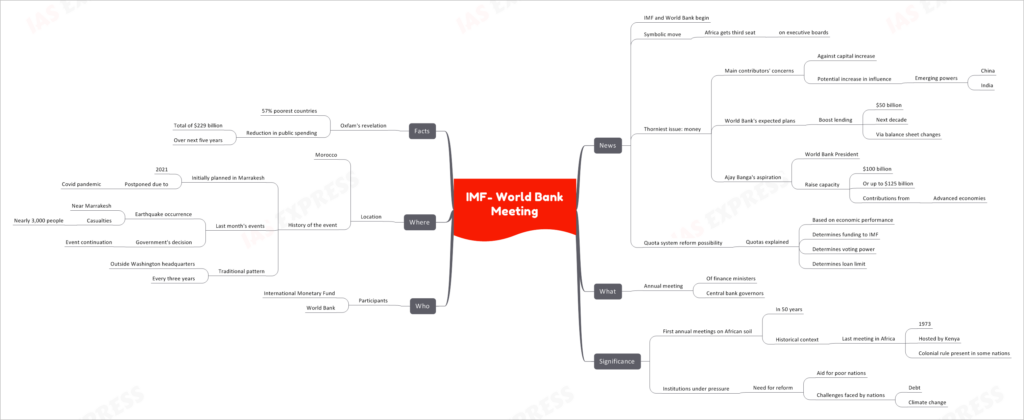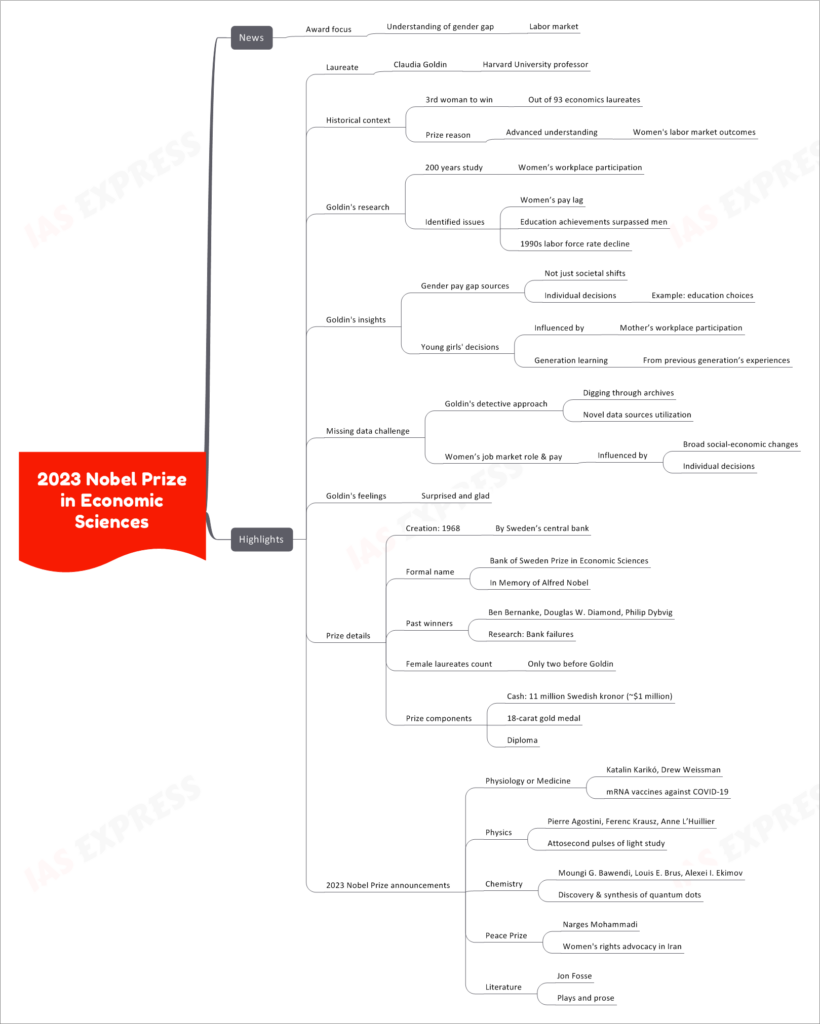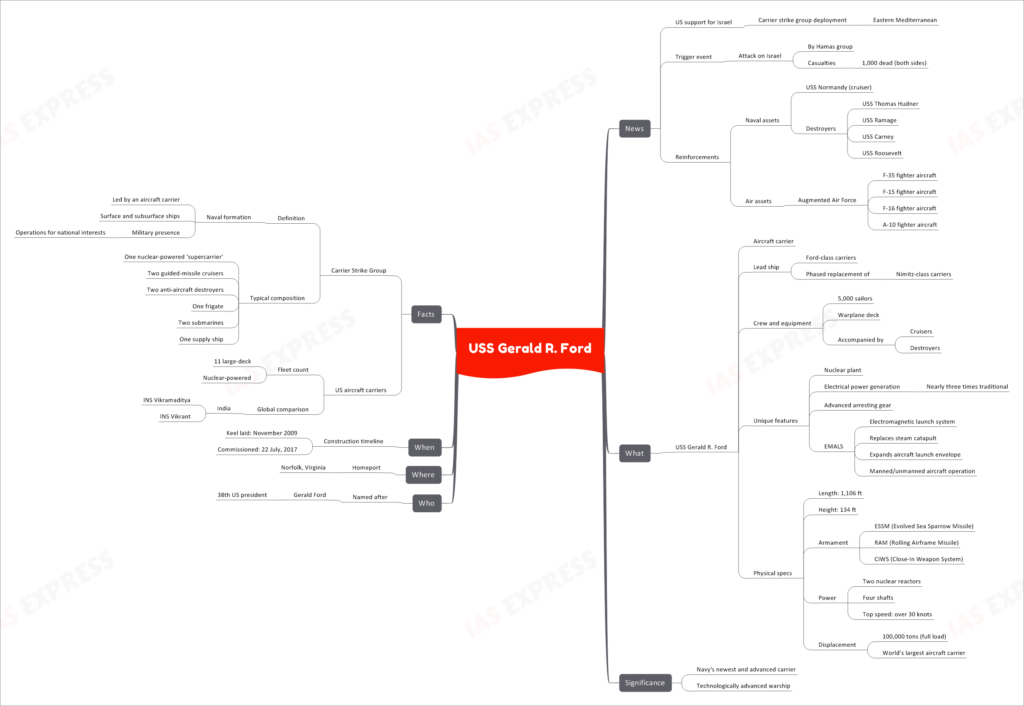[Newsbits] 09.10.2023

IMF- World Bank Meeting
The recent news regarding the International Monetary Fund (IMF) and the World Bank's annual meeting has sparked significant interest and debate among global stakeholders. This article provides an in-depth look at this important event, covering various aspects such as the meeting's significance, participants, location, and key facts.
IMF and World Bank Begin
The IMF and World Bank have officially commenced their annual meeting, signifying a symbolic move towards addressing critical global financial issues. This year's meeting has several noteworthy points to consider:
Africa Gets Third Seat on Executive Boards
One significant development is the allocation of a third seat for Africa on the executive boards of these international financial institutions. This move aims to provide African nations with a more prominent role in shaping economic policies on the global stage.
Thorniest Issue: Money
Money matters are at the forefront of discussions during this annual meeting, with various concerns and aspirations being raised:
Main Contributors' Concerns
- Against Capital Increase: Some main contributors to the IMF and World Bank are wary of a proposed capital increase, fearing the potential economic burden it might impose.
- Potential Increase in Influence: Emerging powers like China and India aspire to have a greater say in the institutions' decision-making processes, which could shift the global economic power balance.
World Bank's Expected Plans
The World Bank has outlined its plans to boost lending over the next decade, with an ambitious target of providing $50 billion in financial support. This increase is expected to be facilitated through changes in the institution's balance sheet.
Ajay Banga's Aspiration
World Bank President Ajay Banga aims to raise the institution's lending capacity significantly, potentially reaching up to $125 billion. To achieve this goal, contributions from advanced economies will play a crucial role.
Quota System Reform Possibility
Discussions about reforming the quota system within these financial institutions are on the table:
Quotas Explained
- Quotas are allocations of financial resources based on a country's economic performance.
- They determine a nation's funding allocation, voting power, and loan limit within the IMF and World Bank.
What
Annual Meeting
The IMF-World Bank meeting is an annual gathering that brings together finance ministers and central bank governors from around the world. It serves as a platform for discussing crucial global financial issues.
Significance
This year's annual meeting holds significant importance for several reasons:
First Annual Meetings on African Soil in 50 Years
This event marks the first time in half a century that the IMF and World Bank have held their annual meetings in Africa. This historical context is essential to understanding the significance of this year's meeting:
Last Meeting in Africa
- The last such meeting in Africa took place in 1973 and was hosted by Kenya.
- At that time, many African nations were still under colonial rule.
Institutions Under Pressure
Both the IMF and World Bank face increasing pressure to reform their operations and policies, particularly in response to the following challenges faced by nations:
Aid for Poor Nations
- There is a growing need to provide more substantial aid to economically disadvantaged nations.
- The meeting aims to address how these institutions can better support such countries.
Challenges Faced by Nations
- Nations worldwide are grappling with issues such as debt and climate change.
- The meeting provides a forum for discussing strategies to address these challenges effectively.
Who
Participants
The key participants in this annual meeting are the International Monetary Fund (IMF) and the World Bank.
Where
Location
This year's meeting is taking place in Morocco. The choice of location and the historical context of the event are noteworthy:
History of the Event
- Initially planned in Marrakesh in 2021, the event was postponed due to the Covid-19 pandemic.
- Recent events, including an earthquake near Marrakesh, prompted discussions on whether to continue with the event.
- The traditional pattern of holding the meeting outside the institutions' Washington headquarters every three years has been disrupted.
Facts
One of the key facts associated with this year's IMF-World Bank meeting is the revelation by Oxfam:
Oxfam's Revelation
Oxfam has highlighted a critical issue concerning the world's poorest countries:
- Oxfam reports that 57% of the world's poorest countries are set to experience a reduction in public spending amounting to a total of $229 billion over the next five years.
Protocol for Management of Malnutrition in Children
The recent launch of the "Protocol for Management of Malnutrition in Children" signifies a significant step in addressing malnutrition among children in India. This standardized national protocol provides detailed guidance for the identification and management of malnourished children, particularly at the Anganwadi level.
What
Standardized National Protocol
The "Protocol for Management of Malnutrition in Children" serves as a standardized national guideline that outlines the specific steps for:
- Identification: Accurately identifying malnourished children, including those suffering from severe acute malnutrition (SAM).
- Management: Offering comprehensive management strategies to address malnutrition effectively, with a focus on intervention at the Anganwadi level.
Significance
Ministry's Statement
The Ministry of Women and Child Development has emphasized that the identification and treatment of malnourished children are integral components of "Mission Poshan 2.0." This indicates a shift from previous approaches, particularly in the treatment of Severe Acute Malnutrition (SAM), which primarily relied on facility-based approaches.
How
Detailed Procedure
The "Protocol for Management of Malnutrition in Children" provides a comprehensive and detailed procedure for various aspects of malnutrition management, including:
- Identification of Malnourished Children: Clear guidelines for identifying malnourished children, ensuring accurate and timely assessment.
- Management at Anganwadi Level: Detailed strategies and interventions for addressing malnutrition at the Anganwadi centers, which are critical in reaching children at the grassroots level.
- Decision-Making: Guidelines for making crucial decisions regarding the referral of severely malnourished children, nutritional management, and follow-up care.
Who
Developers
This essential protocol has been developed collaboratively by the Ministry of Women and Child Development, in consultation with inputs from the Health Ministry. The involvement of these key government departments underscores the seriousness and commitment to combatting child malnutrition in India.
Indian Military Heritage Festival
The Indian Military Heritage Festival is a remarkable event that aims to showcase and celebrate India's rich military heritage and traditions. This festival is a significant endeavor to bridge the knowledge gap among the general public regarding military history, heritage, and contemporary security concerns.
What
Focus
The primary focus of the Indian Military Heritage Festival is on India's:
- Rich Military Heritage: Highlighting the historical contributions and achievements of the Indian military over the years.
- Traditions: Showcasing the unique customs, rituals, and practices that have defined India's military culture.
Why
Awareness Gap
The festival seeks to address the substantial knowledge gap that exists among the general public when it comes to:
- Military History: Many people have limited knowledge about India's military history and its significance.
- Heritage: The rich military heritage of India often remains unexplored and underappreciated.
- Security Concerns: Understanding contemporary security concerns is crucial for the public's awareness and engagement.
National Discourse Enhancement
By bridging the cultural calendar gap, the festival aims to enhance the national discourse on military matters, fostering a deeper appreciation of India's military heritage and its role in national security.
How
Informative Sessions
The Indian Military Heritage Festival offers a diverse range of informative sessions covering various aspects of India's military history and heritage. These sessions include:
- Indigenous Historical Knowledge: Uncovering lesser-known aspects of India's military past.
- India in World Wars: Exploring India's contributions and experiences in global conflicts.
- Post-Independence Challenges: Examining the military's role in shaping India's journey post-independence.
- War and Conflict Understanding: Delving into the dynamics of war and conflict, both historical and contemporary.
- War Through Fiction and Media Lens: Analyzing how war is portrayed in literature, cinema, and media.
Activities' Goal
The goal of these activities is to enhance the understanding of:
- Military Heritage: To provide insights into India's military legacy and traditions.
- Contemporary Security Concerns: To shed light on the current challenges and strategies in the realm of national security.
- Strategy: To facilitate discussions on military strategy and its importance.
- Self-Reliance Push: To promote the Atmanirbhar Bharat program, an initiative by the Government of India to enhance self-reliance and indigenous capabilities.
Who
Organizers
The Indian Military Heritage Festival is organized by the United Service Institution of India, a distinguished institution with a rich history.
Significance
Distinction
The United Service Institution of India holds the distinction of being the oldest think tank in India, further emphasizing the importance and credibility of the Indian Military Heritage Festival.
When
Date
The festival is scheduled to take place on October 21 and 22, providing a unique opportunity for people to immerse themselves in India's rich military history and traditions.
2023 Nobel Prize in Economic Sciences
The 2023 Nobel Prize in Economic Sciences has been awarded to Claudia Goldin, a distinguished professor at Harvard University. Her groundbreaking research in economics has significantly advanced our understanding of the gender gap in the labor market.
Award Focus: Understanding the Gender Gap in the Labor Market
The Nobel Prize in Economic Sciences for 2023 recognizes Claudia Goldin's pivotal work in comprehending the complexities of the gender gap in the labor market, particularly with respect to women's employment outcomes.
Highlights
Laureate: Claudia Goldin
- Claudia Goldin, a Harvard University professor, has been honored as the laureate of the 2023 Nobel Prize in Economic Sciences.
Historical Context
- Claudia Goldin's win is historic as she becomes the third woman to receive the Nobel Prize in Economic Sciences out of a total of 93 economics laureates.
- Her recognition is attributed to her advanced understanding of women's labor market outcomes.
Goldin's Research
A 200-Year Study
- Claudia Goldin's research spans a remarkable 200-year history, focusing on women's workplace participation.
Identified Issues
- Her extensive research has identified critical issues such as the gender pay gap, women surpassing men in educational achievements, and a decline in the labor force rate during the 1990s.
Goldin's Insights
Gender Pay Gap Sources
- Claudia Goldin's work has shown that the gender pay gap is not solely a result of societal shifts but also influenced by individual decisions, including education choices.
Young Girls' Decisions
- She has highlighted how young girls' decisions regarding their careers are influenced by factors like their mothers' workplace participation. This underscores the importance of generational learning and role models.
Missing Data Challenge
- Goldin's research often involved tackling the challenge of missing data. Her detective approach involved extensive efforts, including digging through historical archives and utilizing novel data sources.
- Her findings suggest that women's roles and pay in the job market are influenced by broad social-economic changes and individual decision-making.
Goldin's Feelings
- Claudia Goldin expressed surprise and gladness upon receiving the prestigious Nobel Prize in Economic Sciences, acknowledging the significance of her work in addressing gender disparities in the labor market.
Prize Details
Creation and Formal Name
- The Nobel Prize in Economic Sciences was established in 1968 by Sweden's central bank and is formally known as the "Sveriges Riksbank Prize in Economic Sciences in Memory of Alfred Nobel."
Past Winners
- Previous laureates of the Nobel Prize in Economic Sciences include notable figures like Ben Bernanke, Douglas W. Diamond, and Philip Dybvig, recognized for their research on bank failures.
Female Laureates Count
- Claudia Goldin's win increases the count of female laureates in the field, which was previously limited to only two.
Prize Components
- The Nobel Prize in Economic Sciences includes a monetary award of 11 million Swedish kronor (approximately $1 million), an 18-carat gold medal, and a diploma.
2023 Nobel Prize Announcements
- The 2023 Nobel Prize announcements also recognized significant achievements in other fields:
- Physiology or Medicine: Katalin Karikó and Drew Weissman were awarded for their work on mRNA vaccines against COVID-19.
- Physics: Pierre Agostini, Ferenc Krausz, and Anne L’Huillier received the prize for their study of attosecond pulses of light.
- Chemistry: Moungi G. Bawendi, Louis E. Brus, and Alexei I. Ekimov were honored for their discovery and synthesis of quantum dots.
- Peace Prize: Narges Mohammadi received recognition for her advocacy of women's rights in Iran.
- Literature: Jon Fosse was acknowledged for his contributions to plays and prose.
Abkhazia
Abkhazia, a region in the South Caucasus, has been a subject of international interest due to its complex political status and ongoing developments.
Naval Base Construction by Russia
Recent news has reported the construction of a naval base by Russia in Abkhazia, a breakaway region of Georgia. This development has added to the longstanding tensions in the area and sparked international concern.
What
Partially Recognized State
Abkhazia is a partially recognized state, meaning that while some countries acknowledge its sovereignty, it lacks universal recognition as an independent nation. This ambiguous status has made it a focal point of regional disputes.
Black Sea Coast Location
Situated along the eastern coast of the Black Sea, Abkhazia boasts a strategically significant coastal location, which has both economic and geopolitical implications.
Where
Eastern Coast of the Black Sea
Abkhazia is located on the eastern coast of the Black Sea, sharing borders with Georgia to the east and Russia to the north.
When
2008 Conflict: Russia-Georgia War
Abkhazia's recent history is heavily marked by the 2008 conflict between Russia and Georgia, which had significant consequences:
Moscow's Recognition Post-War
Following the Russia-Georgia war, Moscow recognized the independence of Abkhazia and South Ossetia, two breakaway regions in Georgia. This recognition further complicated the regional dynamics and escalated tensions.
Georgia's Aspirations for Integration
Georgia, in the aftermath of the 2008 Russia-Georgia war, has expressed strong aspirations for integration into the European Union (EU). The conflict served as a catalyst for Georgia to accelerate its efforts to align itself more closely with European institutions.
USS Gerald R. Ford
US Support for Israel: Carrier Strike Group Deployment
Recent news has highlighted the deployment of the USS Gerald R. Ford and its associated strike group to the Eastern Mediterranean in support of Israel. This deployment was triggered by an attack on Israel by the Hamas group, resulting in casualties on both sides, with over 1,000 dead.
Reinforcements
To bolster the USS Gerald R. Ford's capabilities, additional naval and air assets have been deployed to the region:
Naval Assets
- USS Normandy (cruiser)
- Destroyers:
- USS Thomas Hudner
- USS Ramage
- USS Carney
- USS Roosevelt
Air Assets
- Augmented Air Force with:
- F-35 fighter aircraft
- F-15 fighter aircraft
- F-16 fighter aircraft
- A-10 fighter aircraft
What
USS Gerald R. Ford: An Overview
The USS Gerald R. Ford is an aircraft carrier, serving as the lead ship of the Ford-class carriers and marking the phased replacement of the Nimitz-class carriers. It boasts an impressive crew and equipment, unique features, and notable physical specifications:
- Crew and Equipment: It is manned by 5,000 sailors and features a warplane deck accompanied by cruisers and destroyers.
- Unique Features:
- Nuclear plant for propulsion.
- Advanced arresting gear.
- EMALS (Electromagnetic Aircraft Launch System) replacing traditional steam catapults, allowing for expanded aircraft launch capabilities, including manned and unmanned aircraft operations.
- Physical Specs:
- Length: 1,106 ft
- Height: 134 ft
- Armament:
- ESSM (Evolved Sea Sparrow Missile)
- RAM (Rolling Airframe Missile)
- CIWS (Close-In Weapon System)
- Power:
- Powered by two nuclear reactors.
- Four shafts.
- Top speed of over 30 knots.
- Displacement:
- 100,000 tons at full load, making it the world's largest aircraft carrier.
Significance
The USS Gerald R. Ford holds immense significance as the Navy's newest and most technologically advanced aircraft carrier, showcasing cutting-edge capabilities and serving as a symbol of American military strength.
Who
Named After Gerald Ford
The USS Gerald R. Ford is named after the 38th President of the United States, Gerald Ford, in honor of his contributions to the nation.
Where
Homeport: Norfolk, Virginia
The USS Gerald R. Ford is based in Norfolk, Virginia, serving as its homeport.
When
Construction Timeline
The carrier's construction timeline is as follows:
- Keel laid: November 2009
- Commissioned: July 22, 2017
Facts
Carrier Strike Group
A Carrier Strike Group (CSG) is a vital naval formation, typically led by an aircraft carrier, consisting of surface and subsurface ships. It serves various military and strategic purposes, including operations for national interests.
Typical Composition
A typical CSG composition includes:
- One nuclear-powered 'supercarrier.'
- Two guided-missile cruisers.
- Two anti-aircraft destroyers.
- One frigate.
- Two submarines.
- One supply ship.
US Aircraft Carriers
The United States possesses a formidable fleet of aircraft carriers, characterized by their large-deck and nuclear-powered design.
Fleet Count
- The US Navy operates 11 large-deck, nuclear-powered aircraft carriers.
Global Comparison
When compared to other nations, the United States maintains a significant advantage in terms of aircraft carrier capability. For example, India operates aircraft carriers like INS Vikramaditya and INS Vikrant, but the US fleet is more extensive and technologically advanced.






